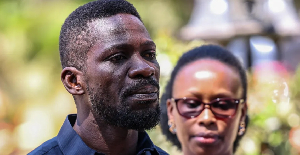Eight regional directors of health services have been reposted in the latest shakeup at the Ghana Health Service (GHS), Starr News can confirm.
The affected directors in the reshuffle include: Dr. Kofi Issah, who is moving from the Upper East region to Brong Ahafo; Dr. Timothy Letsa, reposted from Brong Ahafo to the Volta region; Dr. Joseph Teye Nuertey, transferred from Volta to the Upper West region and Dr. Winfred Ofosu, reassigned from the Upper West to the Upper East region.
Also on the restructuring list are: Dr. Jacob Mahama, who has been released from the Northern region to the Western region; Dr. Emmanuel Tinkorang, the Western Regional Director, now shifted to the Ashanti; Dr. Alexis Nang-Baifubah, Ashanti Regional Health Director, dispatched to Central region and Dr. Samuel Kwashie, the Central Regional health boss, heading for the Northern region.
The reshuffled directors have been asked to take note that the transfer takes effect from October 1, this year. The notice is contained in a letter dated 7th August, 2017 and signed by the Director General of the GHS, Dr. Anthony Nsiah-Asare.
“I wish to inform you that the Service, as part of measures being taken to strengthen healthcare delivery at all levels, has decided to repost some of the Regional Directors of Health Service as indicated in the table below with effect from 1st October, 2017,” the letter stated.
It continued: “The affected Directors are entreated to properly hand over to their colleagues with detailed handing over notes, copies of which should be submitted to this office, prior to their assumption of duty in their new regions.”
Public hails Reshuffle
The restructuring move is the first major reshuffle since Dr. Nsiah-Asare took over from his predecessor, Dr. Ebenezer Appiah-Denkyira, early in 2017.
It has received applause from some people in the Upper East region where Dr. Kofi Issah will be remembered for his 2016 controversial “missing cars” claims that went viral. And he will also be remembered for the apology letter he wrote later to the Ghana Health Service Council after the Director General at the time had said his claims were not only “false” but also aimed at “tarnishing the reputation” of his predecessor, Dr. John Koku Awoonor-Williams.
“I write to express my sincere gratitude to you and the Ghana Health Service Council for the opportunity to brief the Council on the situation surrounding the five vehicles. I also wish to take the opportunity to thank the Council for recommending me (from poor, rural and deprived background) to the position of Regional Director in the Ghana Health Service.
“It is these poor, rural and humble beginnings that influenced my approach to the situation surrounding the five vehicles for which I wish to state that it was regrettable. The experience has taught me a revealing lesson regarding the operations of the service in general and offered me the opportunity to take a new look at working to improve management and team work in the service,” Dr. Issah had ‘sobbed’ in a letter dated 27th October, 2016.
The “false claims”, according to the former Director General, almost cost the region a 9-million-US-dollar project which Dr. Awoonor-Williams had secured with the Korean International Cooperation Agency (KOICA) to help reduce deaths and diseases among pregnant women, nursing mothers and newborns in the region.
KOICA, following the “missing cars” public announcement by Dr. Issah, reportedly became “apprehensive” and cancelled an agreement it had signed with the GHS for the project to be executed in the Upper East region. Dr. Appiah-Denkyira said it took his own intervention to get KOICA to reverse the decision. The same project was launched in 2017 in the region during the directorship of Dr. Issah, who now returns to the Brong Ahafo region where, until 2015, he used to be a Deputy Regional Director of Health.
“The general reposting is a perfect start for Dr. Nsiah-Asare. The service needs a fresh air everywhere. And that is what the new Director General has done. As a well-respected and well-seasoned administrator, the Director General should stand his ground because some lobbyists or some self-seeking members of one group or another might approach him or pass through somebody, trying to influence him to alter the good change he has made as far as these transfers are concerned.
“He should be his own man as usual. The public is watching and we are ready to support him to succeed. He shouldn’t allow any form of plea or pressure to get in his way. We want to see a positive change in the regions. I worked with him (Dr. Nsiah-Asare) when he was at the Komfo Anokye Teaching Hospital. He should be his own man as usual. He should be firm as usual. This is a perfect start,” a medical practitioner, who does not want his name mentioned, told Starr News.
Structures and Expectations
Statistics available on the GHS website today show there are 8 regional hospitals in Ghana with 95 district hospitals and 110 District Health Administrations supported by District Health Management Teams, District Health Committees and Sub-District Health Management Teams.
The Service is governed by a 12-member Council whose functions are to, among others, ensure the “implementation of the functions of the Service, submit to the Minister [of Health] recommendations for health care delivery policies and programmes and promote collaboration between the Ministry of Health, Teaching Hospitals and the Service”.
There are 13 administrative districts, 86 health sub-districts and 297 health facilities in the Upper East region, with the Ashanti, Ghana’s most densely populated region, having 530 health facilities and 326 health institutions in the Western region.
Whilst diseases like cholera, typhoid, pulmonary tuberculosis, anthrax, measles, chicken pox, yellow fever, infectious hepatitis, pertussis, tetanus and trachoma have remained common in the country, malaria is still the leading cause of deaths and admissions at health facilities across Ghana. Ghana, according to a 2016 GHS report, records 3.5 million malaria cases every year with 900,000 of the cases recorded among children under five years.
The reposted regional directors have a crucial task ahead- to, among other expectations, make a progressive difference by lessening the disease burdens in their new administrative regions with the resources at their disposal.
General News of Monday, 14 August 2017
Source: starrfmonline.com













